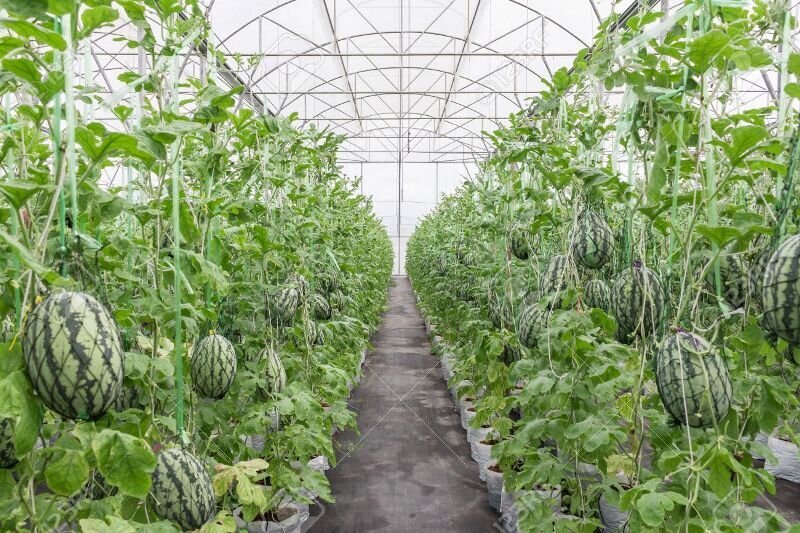Greenhouse output expected to reach 3.7m tons by Mar. 2025

TEHRAN- The head of Iranian Agriculture Ministry’s Greenhouse, Medicinal Plants and Edible Mushroom Affairs Bureau has announced that over 3.7 million tons of high-quality greenhouse products are expected to be produced in the country by the end of the current Iranian calendar year (late March 2025).
Speaking to the press on the sidelines of the 7th International Agriculture, Horticulture, Greenhouses, Inputs and Agriculture Machinery Exhibition of Iran (IFarm 2024), Elham Fatahi-Far said Iran's modern greenhouses have exported 240,000 tons of products worth about $150 million in the first four months of the current Iranian calendar year (March 20-July 21), IRNA reported.
“Due to the increase in the amount of greenhouse production, it is necessary to provide the required inputs such as seeds, fertilizers, and growing mediums in sufficient quantity and with good quality and reasonable price to the greenhouses,” Fatahi-Far said.
She put the total area of the country’s greenhouses at 27,000 hectares, of which 8,761 hectares are incomplete and under construction.
“With the construction of each hectare of the greenhouse, direct and stable employment will be created for about 10 people, and about twice the same number will be employed indirectly,” she said.
Earlier this month, the director of the Iranian Agriculture Ministry’s Greenhouse Development Program Mehdi Lotfizadeh said the ministry plans to increase the country’s greenhouse output to 10 million tons by the end of the seventh National Development Plan (2027).
“To achieve this amount of greenhouse production, 30,520 hectares of greenhouse development has been seen in the seventh National Development Plan,” Lotfizadeh said.
According to the official, the Agriculture Ministry needs 7.3 quadrillion rials (about $14.6 billion) of investment to achieve the above-mentioned goal.
“Currently, the country has reached self-sufficiency in the knowledge and technology of building greenhouses, and this knowledge is exported to other countries where Iranian companies compete in foreign projects with other producers,” he said.
Last July, Lotfizadeh announced that 23,000 hectares of land are under greenhouse cultivation throughout the country.
The official also said that 150,000 hectares of new greenhouses are planned to be set up in the country during a five-year program based on the Seventh National Development Plan.
As stated by the deputy agriculture minister, the development of greenhouse cultivation is a major policy of the Agriculture Ministry.
In this regard, several projects have been defined and introduced to the banks, and as soon as the notification is made, the projects will receive facilities and their implementation will begin, the official added.
In recent years, the water crisis has caused serious challenges in Iran’s agriculture sector.
To solve this problem, several solutions, including the implementation of pressurized irrigation projects and greenhouse cultivation, have been emphasized by experts and officials in this sector.
Iranian Agriculture Ministry’s Greenhouse Development Program is one of the priority projects of this ministry which aims at increasing productivity, efficiency, and water consumption management in the agriculture sector.
The program was approved in the Iranian calendar year 1395 (which ended on March 20, 2017) under the framework of the National Resilient Economy Plan.
The development of the country’s agricultural parks and greenhouses not only is going to create new job opportunities but also increases the country’s non-oil exports and helps preserve the environment and the national water and soil resources.
Cultivation in the controlled space of the greenhouse will have an average of 10 times higher yield per unit area than outdoor cultivation due to suitable environmental conditions.
For example, in the case of cucumber, each square meter in the greenhouse will have a production capacity of 20 kilograms of cucumber, while compared to an outdoor production, the production capacity of one square meter of arable land will be much lower and about two kilograms.
Significant reduction in water consumption in modern greenhouses is in fact the major advantage of greenhouse cultivation.
In greenhouse cultivation, due to the closed environment, water loss through various evaporation ways is greatly reduced. Also, through mechanized irrigation methods such as irrigation canvas and irrigation tape, water consumption is minimized.
Increased control over pests, weeds, and diseases is the other advantage of greenhouse cultivation.
In greenhouse cultivation, due to accurate monitoring and control of pests and diseases, especially the use of biological control methods and a sharp reduction in the use of chemical pesticides, we will see an increase in product quality, that will lead to the popularity of the product in the market and increase export capability.
As a result, along with preserving the soil and environment, we will see good foreign currency income.
EF/MA
Leave a Comment